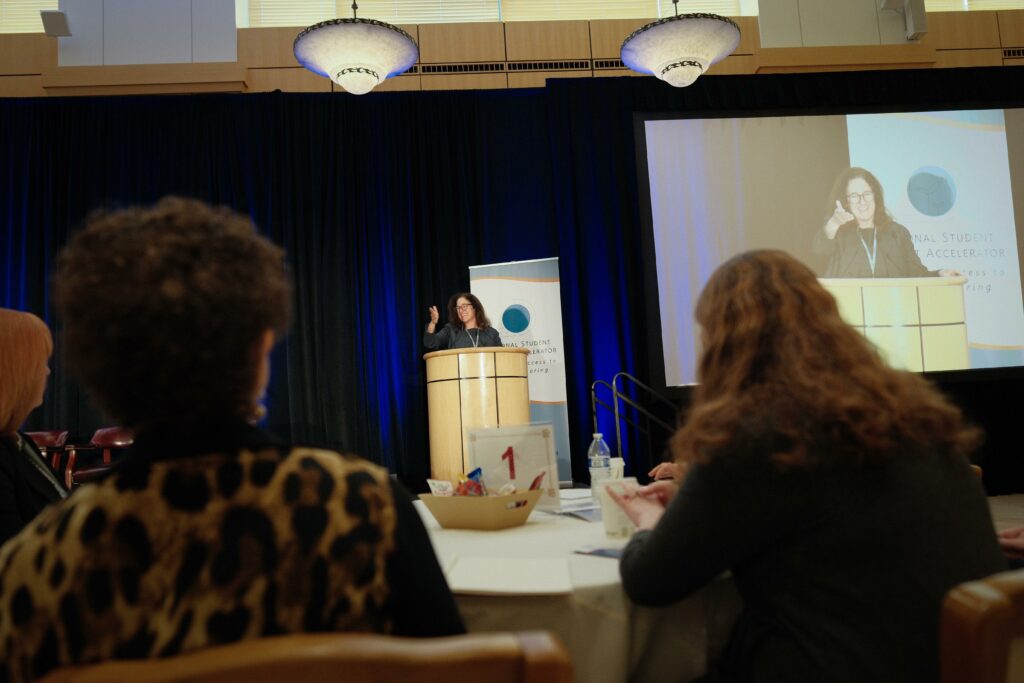News
Developing and staffing the kind of tutoring that research has shown is most effective—often referred to as high quality, or high-impact tutoring—is complex, time-consuming, and expensive. Tutors meet with students at least three times a week, in small groups or one-on-one. Work should be targeted to a specific subject and aligned to high-quality curriculum, and should develop strong tutor-tutee relationships.
“High-impact tutoring is not homework help. They’re not sporadically dropping in,” said Carly Robinson, a senior researcher at Stanford University’s Graduate School of Education who works with the National Student Support Accelerator, a group promoting research-based tutoring programs.
“The truth is that there are a lot of scabbed knees and bruises in this work,” Borders, who oversees the state’s tutoring effort, said at a conference held last week at Stanford University about the future of tutoring. “Not going to sugar coat this, guys. It’s hard work.”
Early in the pandemic, experts identified high-dosage tutoring — the kind that’s offered multiple times per week, in small groups, with a consistent tutor — as a potentially successful strategy for helping students plug learning gaps. But more than two years into a national push to expand the reach of tutoring, many schools are still struggling with basics, like how to staff and schedule their programs.
The Stanford Accelerator for Learning hosted the National Student Support Accelerator (NSSA) annual conference on May 9, bringing together a community committed to the power of high-impact tutoring for learners. Collaborative activities throughout the day fostered connections among tutoring providers, researchers, and school district leaders to share information and renew their inspiration.

Of all academic interventions, so-called “high-dosage” tutoring has shown the most evidence of helping students gain academic ground quickly.
Susanna Loeb, the founder and executive director of the National Student Support Accelerator, studies how schools can use and scale up intensive tutoring, which involves one-on-one situations or very small groups meeting at least 30 minutes, three or more times a week.
Loeb, who is also a professor and the director of the education policy initiative at the Graduate School of Education at Stanford University, spoke with Education Week about what goes into effective tutoring.
High-quality tutoring is one of the most effective educational interventions we have – but we need both humans and technology for it to work. In a standing-room-only session, GSE Professor Susanna Loeb, a faculty lead at the Stanford Accelerator for Learning, spoke alongside school district superintendents on the value of high-impact tutoring. The most important factors in effective tutoring, she said, are (1) the tutor has data on specific areas where the student needs support, (2) the tutor has high-quality materials and training, and (3) there is a positive, trusting relationship between the tutor and student. New technologies, including AI, can make the first and second elements much easier – but they will never be able to replace human adults in the relational piece, which is crucial to student engagement and motivation.
Providing students with tutoring in addition to in-class learning time is an oft-prescribed remedy for both catching up students who are behind and accelerating students who are capable of even higher performance. Two common sticking points to providing that remedy are finding additional time in the day, week, or year for the intervention and finding enough qualified personnel. A new study from the National Student Support Accelerator (NSSA) evaluates a promising program that could reduce both of these sticking points to manageable levels.
A two-year grant of $1,000,000 to the National Student Support Accelerator (NSSA), a program devoted to translating research on how tutoring can benefit students into action. This grant will strengthen the high-impact tutoring ecosystem by supporting NSSA in disseminating research on what makes tutoring programs effective to state and local education agencies, ensuring that evidence-based tutoring reaches the students who need it most.